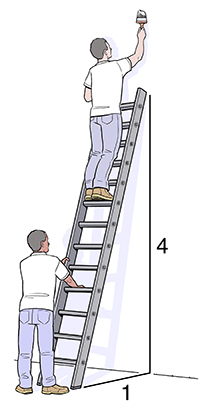Ladder Safety on the Job
Falls happen when you lose your balance. Standing on makeshift supports and using ladders incorrectly can cause you to fall. Using the wrong equipment for a task can also increase your chances of being hurt.
Watch for hazards
-
Makeshift supports. Makeshift supports are never quite right for the job. And they're not safe. For instance, don't stand on top of a trash can or chair instead of a stepstool or ladder. This raises your risk of falling and hurting yourself. Never make a short ladder taller by putting something under the legs. And be careful not to overreach. This can shift your center of gravity and make you lose your balance.
-
Incorrect use of ladders. Using equipment incorrectly is a common fall hazard. Ladders can pose major risks if used incorrectly. If you set a ladder too close or too far from a building, you're more likely to fall off of it. Other causes of falls include setting the ladder on loose, uneven ground. Or using a tall ladder by yourself without securing it. And never stand on the top of a stepladder. Also never use an extension ladder that's too short.
Use the right equipment and use it right
-
Find out what you need ahead of time.
-
Follow safety warnings on equipment.
-
Keep yourself centered over your support. This helps you keep your balance.
-
Keep your arms and legs as close to your center of gravity as possible (don't overreach).
-
Choose the right ladder for the job.
-
Do not use a metal stepladder near power lines or electrical equipment.
-
Do not tie 2 ladders together to make them longer.
-
Do not exceed the ladder’s maximum load rating.
Follow ladder safety rules
-
Inspect the ladder before using it. Look for any signs of damage. These include cracks, rust, or missing rungs.
-
Use the 1 to 4 rule. The base of the ladder needs to be placed 1 foot out from its support for every 4 feet of ladder length.
-
Set and secure the ladder on stable ground.
-
Have someone hold the base of the ladder. The base of the ladder should be secured.
-
Never use the top rung.
-
Wear correct footwear, such as nonslip flat shoes.
-
Make sure the ladder is fully extended before starting work.
-
Have 3 points of contact with the ladder at all times.
-
Do not carry any tools or materials in your hands when climbing a ladder. Carry them in a tool belt. Or raise tools up using a handline.
-
Stay near the middle of the ladder and face the ladder while climbing up or down.
-
Do not ignore nearby overhead power lines.
-
Position portable ladders (also called extension ladders) so that side rails extend at least 3 feet above the landing.
-
Keep ladders free of any slippery materials.
-
Prevent tipping the ladder over sideways or causing the ladder base to slide out.

Online Medical Reviewer:
Chris Southard RN
Online Medical Reviewer:
Marianne Fraser MSN RN
Online Medical Reviewer:
Vinita Wadhawan Researcher
Date Last Reviewed:
4/1/2024
© 2000-2025 The StayWell Company, LLC. All rights reserved. This information is not intended as a substitute for professional medical care. Always follow your healthcare professional's instructions.